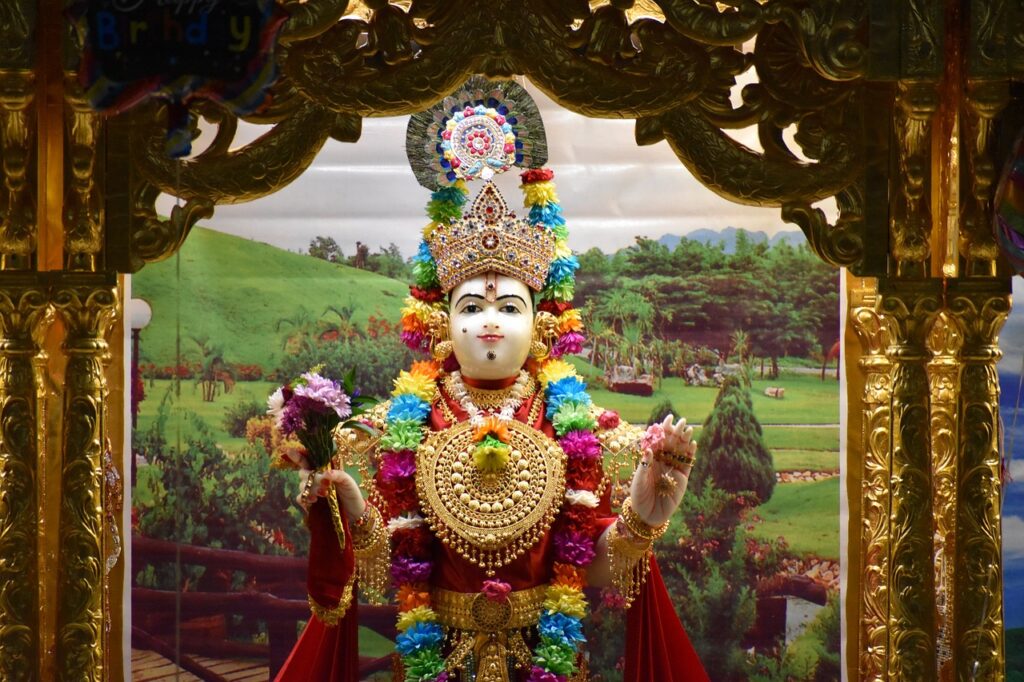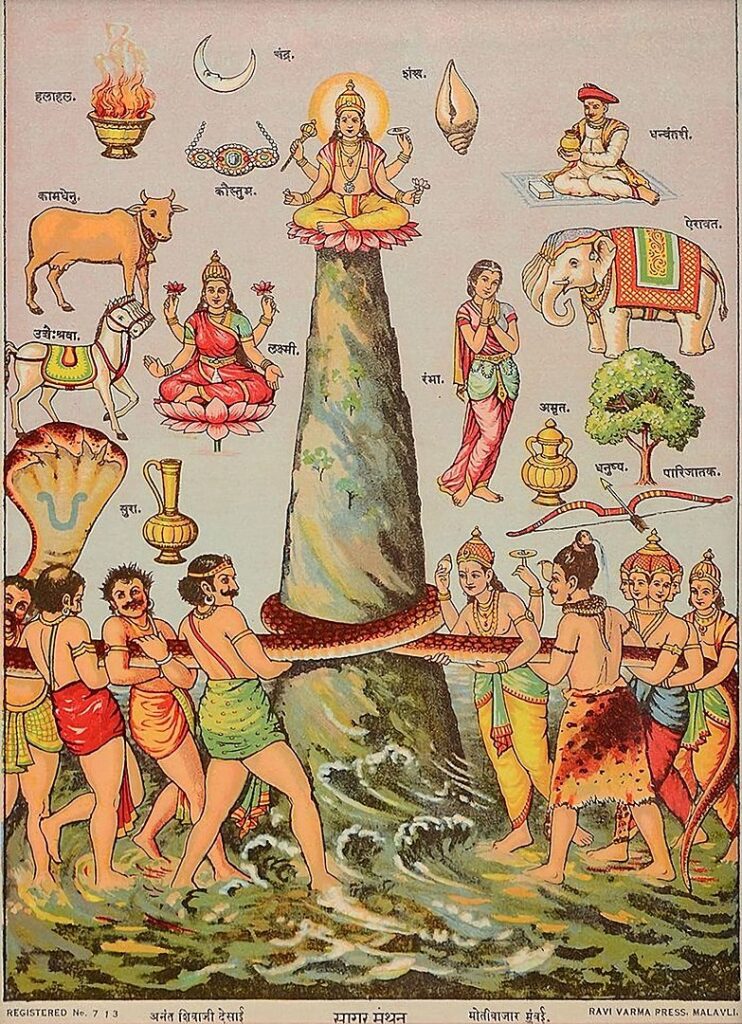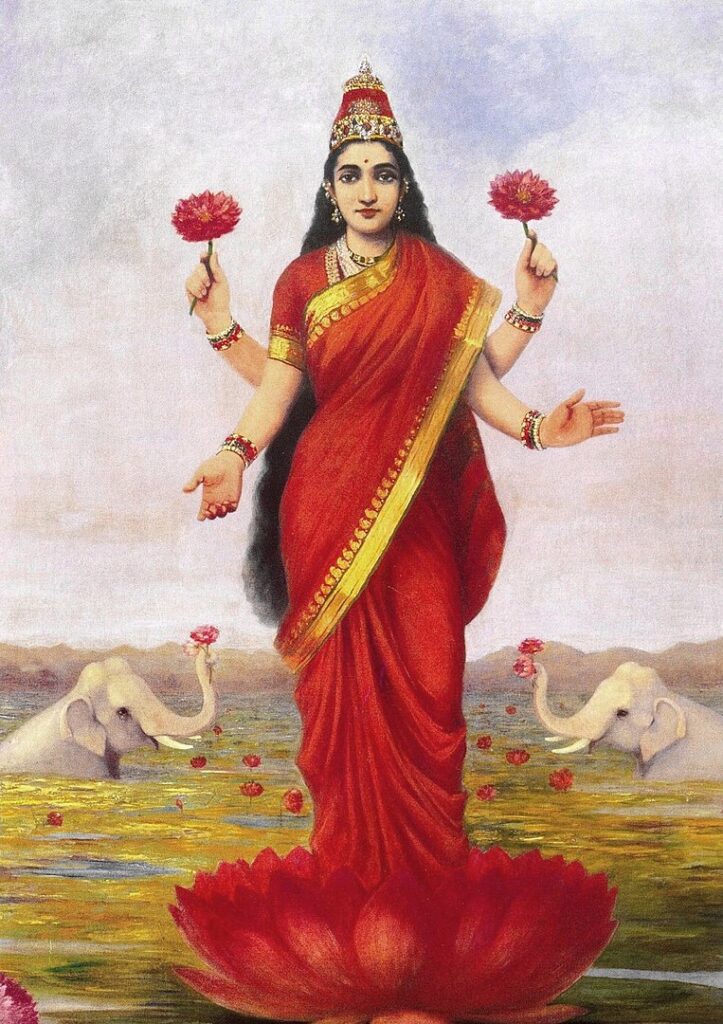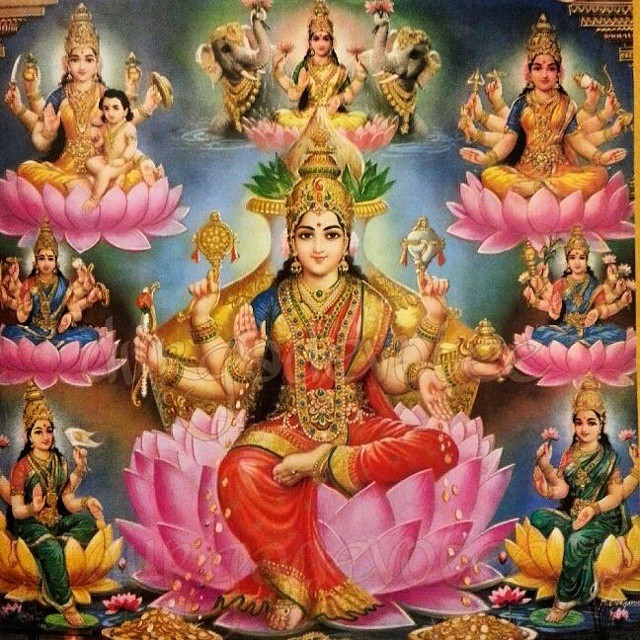
Lakshmi, the eternal companion of Lord Vishnu, is frequently worshiped with him as Lakshmi-Narayana, but also venerated separately, particularly during Diwali. Often depicted seated or standing on a lotus, she carries a lotus and water pot in two hands, while showering coins and offering benedictions with the others. She is clothed in a pink sari, surrounded by auspicious symbols, including elephants spraying water from their trunks. Lakshmi is also known as “Shri,” meaning beautiful, and “Chanchala,” meaning fickle, symbolizing the unpredictable nature of worldly fortune. Nevertheless, she never forsakes her consort, Lord Vishnu. Although she is considered Vishnu’s eternal consort, she appeared from the ocean of milk during the churning of the gods and demons, helping the gods regain their fortune in their battle against the demons. In each of Vishnu’s appearances, such as Vamana, Parashurama, Rama, or Krishna, Lakshmi appeared as Padma or Kamala, Dharani, Sita, and Rukmini, respectively. She is thought to reside on Vishnu’s chest, earning him the name Shrinivas. In South India, particularly at Tirupati, she is known as Padmavati, the consort of Vishnu in the form of Venkateshwara. In this article, you will find a few important facts about the goddess Lakshmi that are worth knowing.
Origin of Goddess Lakshmi
The Bhagavata Purana recounts the fascinating tale of goddess Lakshmi’s origin. It is said that in her first incarnation, she was born as the daughter of the sage Bhrigu and his wife Khyati. However, she later emerged from the milk ocean when it was churned by a joint effort of the Devas and Asuras. This event was prompted by the Devas losing their heavenly kingdom to the Asuras due to a curse from sage Durvasa, causing them to seek Lord Brahma’s assistance. Lord Brahma, in turn, advised them to offer prayers to Lord Vishnu, who was pleased with their devotion and instructed them on how to regain their kingdom.

Following Lord Vishnu’s instructions, the Devas and Asuras made a truce and worked together to churn the milk ocean. Their efforts yielded not only the coveted nectar of immortality but also other treasures, including a potent poison that Lord Shiva eventually consumed. Among these treasures was the goddess Lakshmi, the embodiment of wealth, prosperity, and fortune. She was revered by the great sages and demigods, but despite her beauty and grace, she could not find a suitable husband. She eventually chose Lord Vishnu, who granted her a permanent abode.
Symbols of Goddess Lakshmi
Lakshmi devi is a breathtakingly beautiful deity, gracefully standing on a delicate lotus flower. Her physical appearance is further enhanced by the presence of four arms, two of which hold exquisite lotus flowers, a symbol of self-realization and the varied stages of living beings’ evolution. In one of her lower hands, she blesses those who seek wealth and prosperity, while the other offers blessings in a welcoming, upright position. Additionally, her upper left hand may carry a potted coconut. Her hands symbolize the four main blessings of human existence – dharma (righteousness), artha (wealth), kama (sensual pleasures), and finally moksha (liberation).

Lakshmi devi is adorned with a fragrant lotus garland, and flanked by majestic elephants on either side. These elephants, often seen offering her gifts of garlands or pouring water over her, are accompanied by celestial maidens. The goddess’s complexion takes on different hues, each representing a unique aspect of her divine nature. When her skin is dark, it signifies her connection to Lord Vishnu. A golden yellow complexion indicates that she is the source of all fortune and wealth, while white represents her as the highest expression of nature, the source from which the universe has sprung. Finally, a pinkish hue denotes her benevolent and compassionate nature, as the mother of all beings. Some portrayals of her show that she rides an owl, known as ‘uluka’ in Sanskrit, which is also a name for Indra, the ruler of the heavens.
Eight forms of Goddess Lakshmi
Adi Lakshmi
Adi Lakshmi is the primordial form of the Hindu goddess Lakshmi. Her name is derived from Sanskrit words meaning “goal” and “to understand and know,” and she helps people achieve their objectives by providing them with the wealth they need. Adi Lakshmi’s ultimate aim is to help people attain freedom from the cycle of death and rebirth, and she is also known as “one who bestows liberation.” She is depicted seated on a pink lotus, wearing gold jewelry and holding a lotus and a flag. Adi Lakshmi is a symbol of compassion and is always ready to assist those who strive towards the ultimate spiritual aim of life.

Dhana Lakshmi
Dhana Lakshmi is the Hindu goddess of wealth and prosperity. While ‘dhana’, the Sanskrit word for wealth, traditionally refers to tangible monetary assets, it also encompasses qualities such as willpower, strength, and perseverance. Dhana Lakshmi is believed to favor hardworking individuals by providing the prosperity they need to reach their full potential. She is depicted draped in jewelry, seated on a pink lotus, and possessing six hands that wield various symbols, including a discus, a conch, a bow and arrow, a water pitcher, and gold coins. As the embodiment of all the universe’s wealth, Dhana Lakshmi helps those who strive to overcome their minds and persevere in the face of challenges.
Dhanya Lakshmi
Dhanya Lakshmi is the goddess of agricultural wealth, blessing devotees with the great fortune of food and agricultural resources. Devotees show their gratitude by honoring her before meals and offering food to those in need. Depicted in green garments representing growth and renewal, Dhanya Lakshmi sits on a pink lotus with eight hands holding various symbols, including a mace, lotuses, and agricultural products. She highlights the importance of showing gratitude for Mother Nature’s miracles, which provide nourishment to all, regardless of wealth or status.
Gaja Lakshmi
Gaja Lakshmi is worshiped as the provider of animal wealth, which was important to ancient Indian farmers. She is depicted sitting on a pink lotus flanked by white male and female elephants, with four hands holding lotuses, and displaying Abhaya and Varada mudras. Her blessings remind us of the value of animals in society and the need to treat them with respect and care.
Santana Lakshmi
Santana Lakshmi is worshiped for fertility and symbolizes the blessing of having children. She is depicted wearing gold jewelry, seated on a pink lotus, and with six hands holding a baby and other objects such as pitchers of water. Santana Lakshmi is associated with the warmth and care necessary for raising healthy children, and blesses those who honor parenthood as a sacred duty.
Veera Lakshmi
Veera Lakshmi is a symbol of bravery and valor who blesses worshippers with the strength required to overcome obstacles on the path of one’s material and spiritual life. She is depicted with eight hands wielding a medley of weapons and is known also as Dhairya Lakshmi, who grants one the fearlessness needed to persevere through life’s ups and downs.
Vidya Lakshmi
Vijaya Lakshmi is one of the forms of the Hindu goddess Lakshmi. Her name means “victory,” and she is considered a symbol of success, providing hope and inspiration to her devotees. She is typically depicted wearing red clothing and adorned with flowers, seated on a lotus. She has eight hands, each holding a different object, including a discus, sword, shield, noose, conch, lotus, and making gestures of Abhaya mudra and Varada mudra.

Vijaya Lakshmi is believed to manifest to help people overcome obstacles in their lives with determination and perseverance. She favors those who maintain a positive attitude in the face of difficulties, and her guidance can be invoked for success in any endeavor. However, devotees are especially encouraged to seek her help on the path of spirituality. Overall, Vijaya Lakshmi represents the idea that success can be achieved through hard work, optimism, and a steadfast attitude.
Lakshmi devi and the Tradition of Hera Panchami
Hera Panchami is a significant ritual celebrated during the Rath Yatra festival at the Gundicha temple in Jagannath Puri. It occurs on the fifth day (Panchami) and is attended by a large number of devotees. During Rath Yatra, Lord Jagannath (Narayana) visits the Gundicha temple to enjoy with His siblings, while His consort Lakshmi remains at the main temple in Puri. On Hera Panchami, Lakshmi devi arrives at Gundicha, in the form of Subarna Maha-Lakshmi, to take her husband back. Lakshmi is welcomed with ceremonial offerings, and the priests worship her before taking her to meet with Jagannath.
At the Gundicha temple, Lakshmi enters during the evening rituals and throws the ‘Mohana Churna’. On behalf of Lord Jagannath, she receives an ‘Agyan Mala’ (a garland of consent) and the door is closed. Lakshmi feels neglected and angry, and she asks her servants to break a part of Jagannath’s chariot as revenge for ignoring her.

Feeling guilty, Lakshmi secretly returns to Sri mandira without any procession and fanfare via a lane called the Hera Gohiri Sahi of Puri. On the day after Hera Panchami, the three chariots are turned to face the South in preparation for the return journey. After their nine-day outing, the Bahuda Yatra (Ulta Rath) marks the return of the deities. On Niladri Bije, the concluding day of the Ratha Jatra, Lord Jagannath offers Rasagola as a sweet present to Goddess Lakshmi to earn her favor and regain entry to the Sri mandira, which she had refused to open for him.
Image Credits :
Biswarup Ganguly, CC BY 3.0 via wikimedia commons
Rama19920, CC BY-SA 4.0 via Wikimedia Commons